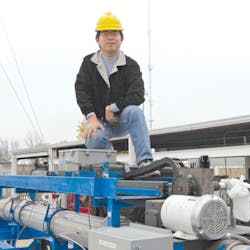Engineering School Innovations: Research Flow Loop
Project Name: Research flow loop with moving camera
Students: Project leader: Feifei Zhang; Project Assistants: Randy Darden and Donald Harries
University: University of Tulsa
Description
The research flow loop is used to study how a clean hole can be created during the drilling process. For example, when a well is being built, solid particles, called “cuttings” are generated as rocks are drilled. The cuttings need to be removed from the well and brought to the surface by circulating drilling fluid. If the concentration of cuttings in the well is too high, it will not only lead to drilling problems, but also decrease the gas or oil production of the well, or even lead to the failure of the well.
To study this more closely, the students are using a high-speed moving camera to watch the movement of solid particles in fluid. Specifically, the flow loop is used to simulate how solid particles move in liquid while in different conditions. A transparent pipe is used so that the behavior of the particles can be closely observed.
The transparent pipe is 81 feet long with an eight-inch diameter. The high-speed camera is installed outside the pipe so it can take high-quality pictures of the moving particles at any location. However, it is imperative to protect the three cables connected to the camera — a power cable, signal transmission cable and control cable — so they do not fail. Since the flow loop is located outdoors in Oklahoma where temperatures can dip as low as 14 degrees Fahrenheit in the winter and soar to 110 degrees Fahrenheit during the summer, the cables could be easily damaged. In addition to the extreme temperatures, the cables need to withstand different weather conditions, including rain, snow, wind, and severe storms.
Equipment
• igus Energy Chain System including cable carrier, cables and a guide trough (donated through igus’ Young Engineers Support (Y.E.S.) Program).
• Basler aviator GigE camera connected to Labview (National Instruments) program on a computer (the program records 100 pictures per second, then transfer the pictures into .avi video).
• Dayton 2 hp motor with a max rpm of 1725.
Video
Click here to see a video of the research rlow loop camera in motion.
Other engineering schools videos are available at bit.ly/awesi001
>> Automation World would like to thank igus for connecting us with the students at the University of Tulsa to report this innovation.
>> If you know of an engineering school project we should feature, contact [email protected].
About the Author
David Greenfield, editor in chief
Editor in Chief

Leaders relevant to this article:
